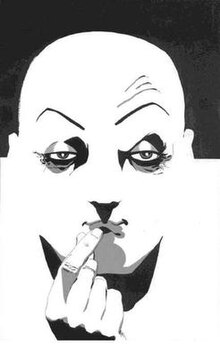
The Elizabeth Arkham Asylum for the Criminally Insane, commonly referred to as Arkham Asylum, is a fictional psychiatric hospital/prison, appearing in American comic books published by DC Comics, commonly in stories featuring the superhero Batman. It first appeared in Batman #258, written by Dennis O'Neil with art by Irv Novick. The asylum serves as a (forensic) psychiatric hospital for the Gotham City area, housing patients who are criminally insane, as well as select prisoners with unusual medical requirements that are beyond a conventional prison's ability to accommodate. Its high-profile patients are often members of Batman's rogues gallery.

The Scarecrow is a supervillain appearing in American comic books published by DC Comics. Created by writer Bill Finger and artist Bob Kane, he debuted in World's Finest Comics #3. The character has become one of the superhero Batman's most enduring enemies belonging to the collective of adversaries that make up his rogues gallery.
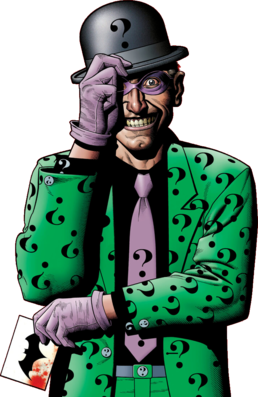
The Riddler is a supervillain appearing in American comic books published by DC Comics. The character was created by Bill Finger and Dick Sprang, and debuted in Detective Comics #140 in October 1948. He has become one of the most enduring enemies of the superhero Batman and belongs to the collective of adversaries that make up his rogues gallery.

Hugo Strange is a supervillain appearing in comic books published by DC Comics, commonly as an adversary of the superhero Batman. The character is one of Batman's first recurring villains, and was also one of the first to discover his secret identity. The character first appeared in Detective Comics #36.

Killer Croc is a supervillain appearing in American comic books published by DC Comics. Created by Gerry Conway, Don Newton and Gene Colan, the character was introduced in Batman #357. He has become one of the most enduring enemies of the superhero Batman and belongs to the collective of adversaries that make up his rogues gallery.
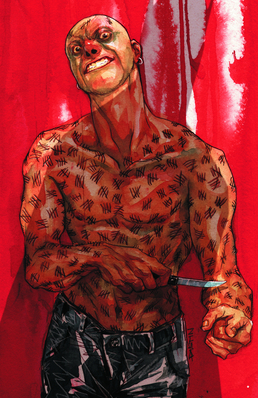
Victor Zsasz, also known as Mr. Zsasz or simply Zsasz, is a supervillain appearing in comic books published by DC Comics. The character first appeared in Batman: Shadow of the Bat #1. He is a sadomasochistic and psychopathic serial killer who carves a tally mark onto himself for each of his victims. A recurring adversary of the superhero Batman, Zsasz belongs to the collective of enemies that make up Batman's rogues gallery.
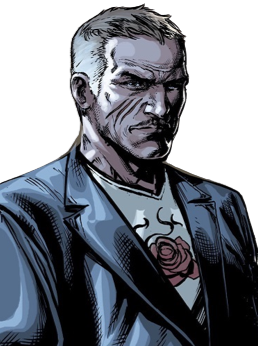
Carmine Falcone is a fictional supervillain in DC Comics, portrayed as a powerful mob boss, an enemy of Batman, and a friend of the Wayne family. He has also been depicted in some versions as the illegitimate father of Catwoman.
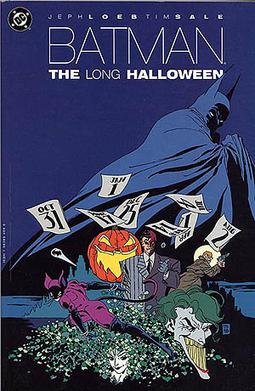
Batman: The Long Halloween is a 13-issue American comic book limited series written by Jeph Loeb with art by Tim Sale. It was originally published by DC Comics in 1996 and 1997. It was the follow-up to three Batman: Legends of the Dark Knight Halloween Specials by the same creative team. The series' success led to Loeb and Sale to reteam for two sequels, Batman: Dark Victory and Catwoman: When in Rome, which are set concurrently.

Batman: Dark Victory is a 14-part American comic book limited series published by DC Comics, featuring the superhero Batman. The series, which ran from 1999 until 2000, was written by Jeph Loeb and drawn by Tim Sale, and it serves as a sequel to Batman: The Long Halloween. Batman: Dark Victory takes place primarily four to five years into Batman's career as a vigilante crimefighter. The plot centers on a series of murders involving Gotham City police officers by a mysterious serial killer only known as the Hangman. Central to the storyline is a territory war between Two-Face and the remnants of the Falcone mob, led by Sofia Falcone.

Sofia Falcone is a villain appearing in DC Comics, primarily in association with the character Batman. Debuting in the 1996–97 comic book limited series Batman: The Long Halloween by Jeph Loeb and Tim Sale, she is introduced as a member of the Falcone crime family, who assists her father Carmine Falcone in unearthing the identity of the "Holiday Killer"—later revealed to be Sofia's own brother Alberto Falcone, a mass-murderer who had been indiscriminately killing Gotham City's citizens in correlation with holidays in the yearly calendar. In the 1999-2000 limited series Batman: Dark Victory which served as a continuation of the arc established in The Long Halloween, Sofia is revealed as the identity behind the murderer known under the alias the Hangman, who had spent over a year targeting and eliminating various members of the Gotham City Police Department, notably in association with former district attorney-turned criminal, Harvey Dent / Two-Face, who ends up killing her during a lengthy confrontation with Batman himself.

Thomas Alan Wayne, M.D. is a fictional character appearing in American comic books published by DC Comics. He is the father of Bruce Wayne (Batman), and husband of Martha Wayne as well as the paternal grandfather of Damian Wayne. Wayne was introduced in Detective Comics #33, the first exposition of Batman's origin story. A gifted surgeon and philanthropist to Gotham City, Wayne inherited the Wayne family fortune after Patrick Wayne. When Wayne and his wife are murdered in a street mugging, Bruce is inspired to fight crime in Gotham as the vigilante Batman.
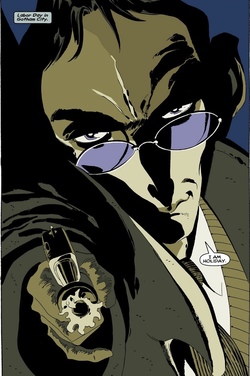
Alberto Falcone is a fictional comic book villain appearing in books published by DC Comics, in particular the Batman books. In addition to being a mobster, he has also made appearances as the Holiday Killer, a serial killer featured in Batman: The Long Halloween and Batman: Dark Victory.
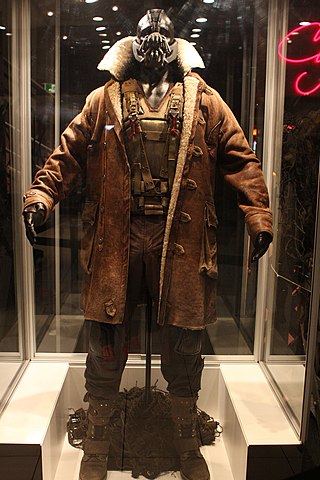
Bane was originally a comic book character and Batman's adversary, but has appeared in several other forms of media. He has been portrayed in live action by Robert Swenson in Batman & Robin, Tom Hardy in The Dark Knight Rises, and Shane West in Gotham. Henry Silva, Héctor Elizondo, Joaquim de Almeida, Ron Perlman, Clancy Brown, Michael Dorn, Danny Trejo, Carlos Alazraqui, Fred Tatasciore, Jason Liebrecht, Steve Blum, JB Blanc, Doug Benson, James Adomian, and Peter Marinker have all provided voice work for the character.
Catwoman is a fictional character first appearing in issue 1 of the Batman comic book. After her debut she would appear in many forms of media including live-action and animated film, radio, live-action and animated television, records, video games, web series, live performance, and podcasts. The character has made live-action appearances in the Batman television series (1966–68), its film adaptation Batman (1966), Batman Returns (1992), Catwoman (2004),The Dark Knight Rises (2012), Gotham (2014–19), and The Batman (2022). The character has also appeared in numerous animated television series and movies, most notably Batman: The Animated Series (1992–95) and The Lego Batman Movie (2017), as well as video games such as the Batman: Arkham series.

The Riddler, a supervillain in DC Comics and an adversary of the superhero Batman, has been adapted into numerous forms of media, including feature films, television series, and video games. The character has been portrayed in live-action by Frank Gorshin and John Astin in the 1960s television series Batman, Jim Carrey in the 1995 film Batman Forever, Cory Michael Smith in the 2014 Fox series Gotham, and Paul Dano in the 2022 film The Batman. Actors who have voiced the Riddler include John Glover in the DC Animated Universe, Robert Englund in The Batman, and Wally Wingert in the Batman: Arkham video games.

The Scarecrow, a supervillain in DC Comics and an adversary of the superhero Batman, has been adapted in various forms of media, including films, television series, and video games. The character has been portrayed in film by Cillian Murphy in The Dark Knight Trilogy, and in television by Charlie Tahan and David W. Thompson in the Fox series Gotham, and Vincent Kartheiser in the HBO Max streaming series Titans. Henry Polic II, Jeffrey Combs, Dino Andrade, John Noble, Robert Englund, and others have provided the Scarecrow's voice in animation and video games.

The character Two-Face was created by Bob Kane and first appeared in Detective Comics #66. However, he did not appear outside comics until half a century later in Batman: The Animated Series. Two-Face has since been substantially adapted from the comics into various forms of media, such as feature films, television series and video games. Two-Face has been voiced by Richard Moll in the DC Animated Universe, Troy Baker in the Batman: Arkham series, Billy Dee Williams in The Lego Batman Movie, and William Shatner in Batman vs. Two-Face. His live-action portrayals include Billy Dee Williams in Batman (1989), Tommy Lee Jones in Batman Forever, Aaron Eckhart in The Dark Knight, and Nicholas D'Agosto in the television series Gotham. In 2009, Two-Face was ranked #12 on IGN's list of the Top 100 Comic Book Villains of All Time.

The supervillain the Penguin, created by Bob Kane and Bill Finger, made his first appearance in Detective Comics #58. Since then, he has been adapted into other forms of media, including feature films, television series, and video games.

Batman: The Long Halloween is a 2021 American two-part animated direct-to-video superhero film produced by Warner Bros. Animation and DC Entertainment, based on the DC Comics storyline of the same name. Part 1 is the 44th film, and Part 2 is the 45th film, of the DC Universe Animated Original Movies, with both parts serving as the third and fourth installments of the Tomorrowverse. The film is directed by Chris Palmer and stars the voices of Jensen Ackles, Josh Duhamel and Naya Rivera in her final film role. The film is dedicated to Rivera following her death the year prior. In both parts of the film, Batman attempts to unravel the mystery of murders committed on holidays throughout the year, and uncover the true identity of the serial killer Holiday.
